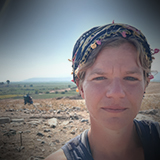Hi, my name is Lisa. I have been working on excavations in Germany, Greece and Turkey since 2009. I have a strong interest in the application of digital methods in classical archaeology in general, but my research focuses on Asia Minor and the regions pottery and topography, mostly but not exclusively in the Classical and Hellenistic periods, and especially in Miletus and its surroundings. Miletus is also the home of my doctoral thesis: “Das Dionysosheiligtum in der Sakrallandschaft von Milet” (The Sanctuary of Dionysos within the Sacral Landscape of Miletus).
About the Sanctuary of Dionysos in Miletus
Between 1973 and 1977, the architect Wolfgang Müller-Wiener conducted an extensive excavation of the small sanctuary of Dionysos in the centre of Miletus. The results of this excavation, however, have only been published in two short preliminary reports and the finds have never been fully examined. The dissertation project was aimed at revisiting the documentation, stratigraphy and finds and placing the development of the sanctuary in the context of the Milesian sacral landscape.
The finds from the area of the sanctuary attest to a dramatic increase of activity around the middle of the 5th century BCE. Traditionally thought of as a blank spot on the map of Milesian research, these finds greatly illuminate the time period after the destruction of Miletus in consequence of the Ionian Revolt. As the new research shows the area had - in that time - not been used as a sanctuary, as there are no clear indications of cult activity before the 3rd century. Instead, the evidence for the Classical period strongly suggests an Insula with domestic houses that were later razed to make room for the temple. From its foundation, dated by an inscription to around 275 BCE, the temenos of Dionysos provides an excellent example of the long term changes in urban development as well as religious tradition, illustrating not only the changes in urban planning, but also the transformation of sacred spaces during late antiquity. The by then most likely faulty old temple building was completely dismantled during late antiquity, and the church of St. Michael was built in the end of the 6th century resp. beginning of the 7th century CE on top of the still solid foundations of its predecessor.
